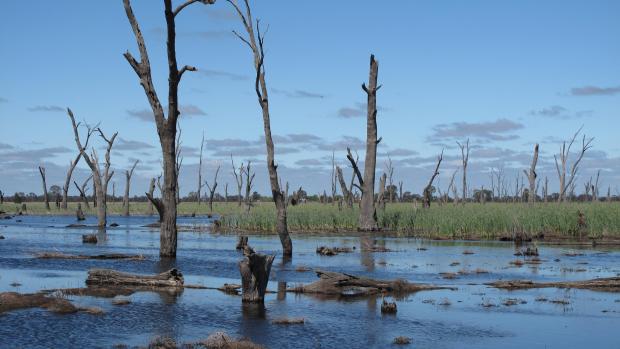Loading
Red gums lovin’ it at McDonalds

We are accustomed to thinking that dry is bad, that drying out means death. However, when it comes to wetlands, the opposite can be true – drying out can mean life.
Before regulation, in the land of droughts and flooding rains, the floodplains and wetlands connected to our rivers would inundate during floods and dry out over subsequent years.
Plants and animals have evolved to adapt to these conditions. During drying times, species like the magnificent river red gum have space and time to breathe and germinate, and banks start to attract terrestrial bird species. When it’s wet, other native aquatic plants thrive, providing food and harbour for water bird species.
However, with modifications to the landscape, some wetlands are almost completely disconnected from all but the largest natural floods.
Further, historic irrigation practices that used wetlands as places to put excess irrigation water, brought with it irregularity, and wet and dry phases have been turned on their heads.
For many of these wetlands, drowned trees and thick blankets of invasive plants, such as cumbungi and common reed, are now common place.
“An important part of our management is ensuring there are wet and dry cycles in our wetlands, if there is enough water available in the system,” North Central CMA Environmental Water Manager Louissa Rogers said.
“A wetland like McDonalds Swamp near Kerang is a great example. Monitoring has shown that in the past, the extent of rushes and reeds increased every summer, invading the open water areas important for a range of waterbirds. These plants have thrived on shallow, warm water and have strangled other native species.
“McDonalds Swamp was filled with environmental water in mid-August last year after 18 months of dry conditions. The watering supported the growth of river red gum saplings and helped a diverse range of waterbirds have a bumper breeding season.
“McDonalds Swamp has now dried, and with effective management we have been able to bolster the health of the river red gum saplings and significantly reduce the march of the reeds and rushes.”
Ms Rogers said it was sometimes hard to understand how dry conditions helped wetlands.
“We see wetlands teaming with life when it is wet and think that’s the way they should always be,” she said. “However, dry times can be just as important as wet times. Managing wetlands can be a balancing act and is certainly not a case of simply just adding water.”
Making sure our wetlands are managed so that they keep on providing the habitat that wetland plants and animals need is part of the government’s broader $222 million Water for Victoria initiative to improve the health of waterways and catchments across regional Victoria.
For more information on McDonalds Swamp’s watering regime, and all the catchment’s watering plans, view the Victorian Environmental Water Holder’s Seasonal Watering Plan 2016-17 , which can be downloaded from www.vewh.vic.gov.au.
-ends-
